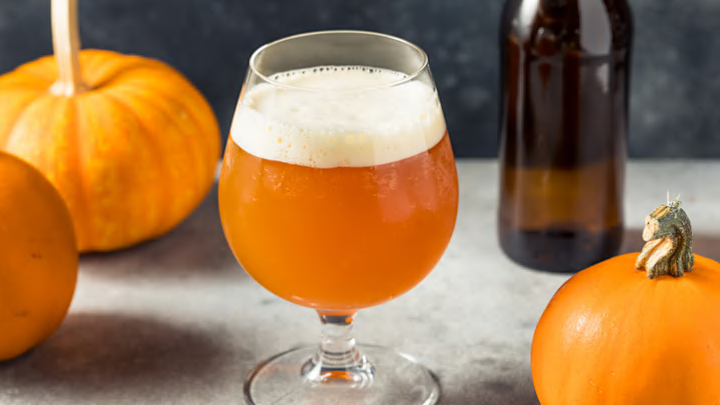Laced with cinnamon, cloves, nutmeg, and other spices more suited for a pie than a pint, pumpkin ales have come to define the flavor of fall for beer lovers in recent years (even if they begin popping up in bars and liquor stores as early as August). While these gourd-infused brews are now a part of the pumpkin spice industry, they actually have roots in a lowly colonial-era drink that was concocted more out of necessity than for flavor.
- The Unceremonious Origins of Pumpkin Beer
- “A Beer of Last Resort”
- The Forgotten Ale Gets a Craft Makeover
The Unceremonious Origins of Pumpkin Beer
Starvation was a looming threat for the New England colonists in the 17th century. Shortages of favorites like wheat and barley meant many families, especially the poor, needed to find a tough, versatile crop that was easy to grow and could survive the bitter Northeast winters. Pumpkins, it turns out, fit the bill perfectly.

“When [the first colonists in New England] come over here, they want to have their European fare, their European food, but they can't grow them yet,” Cindy Ott, associate professor of history and museum studies at the University of Delaware and author of Pumpkin: The Curious History of an American Icon, told Mental Floss in 2020. “So they rely on the pumpkin because it’s prolific [and] grows like a weed.”
Families could roast and eat pumpkin flesh, snack on a handful of seeds, or mash the whole thing together with butter and spices. For some, the fact that pumpkins made up the overwhelming bulk of their diet was enough to inspire tongue-in-cheek poetry with derisive lines like, “We have pumpkins at morning and pumpkins at noon, If it were not for pumpkins, we would be undoon.”
But there was another European staple that pumpkins were about to pinch-hit for in North America: beer.
You May Also Like:
- The First Recipe for “Pompkin” Spice Dates Back to 1796
- Canned Pumpkin Isn’t Actually Pumpkin
- The Most Pumpkin Spice Latte-Obsessed States, Mapped
Add Mental Floss as a preferred news source!
“A Beer of Last Resort”
Without the grains available to make a proper ale, the colonists discovered they could use pumpkins as a cheap, fermentable filler, along with molasses, bran, corn, and other ingredients the average family could scavenge. These early pumpkin ales did the job—but they became known as a drink strictly for the peasants who couldn't get their hands on the real stuff.

“[Colonists] rely on the pumpkin as this cheap substitute, and it gets them through difficult times,” Ott said. “But no one wants it. It’s really like the beer of last resort.” In her book, Ott writes that the flavor was described as having a “slight twang” when compared to more reputable ales of the time.
A handful of pumpkin beer recipes have survived over the years, including these 1771 instructions for “pompion ale”:
“Let the Pompion be beaten in a Trough as Apples. The expressed Juice is to be boiled in a Copper a considerable Time and carefully skimmed that there may be no Remains of the fibrous Part of the Pulp. After that Intention is answered let the liquor be hopped cooled fermented &c. as Malt Beer.”
Over time, as farming practices improved and better ingredients and brewing techniques popped up, the pumpkin ales of the colonies all but disappeared. That is, until the crop took on a whole new meaning centuries later.
The Forgotten Ale Gets a Craft Makeover
In 1985, Bill Owens, owner of Buffalo Bill’s Brewery in Hayward, California, supposedly came across details of a pumpkin beer that George Washington was known to brew. Owens—a popular craft beer pioneer known for his farming acumen and particular choice of ingredients (like sourcing specific hops from Tasmania)—wanted to try a more modern take on the style. His version called for pumpkins to be roasted in his pizza oven and thrown into the brewery’s standard amber ale.

To give the normally mild flavor of pumpkin a bit more oomph, and to move the beer even further away from the original recipes, the brewery added spices like nutmeg and cloves. Today, Buffalo Bill’s Original Pumpkin Ale is considered the world’s first modern take on the style—though it didn’t catch on with everyone immediately.
“I think for the longest time, we were sort of the joke,” Geoff Harries, who worked on those early batches and now serves as the current CEO and master brewer at Buffalo Bill’s, told Mental Floss in 2020. “Even people like Anheuser-Busch came out with commercials making fun of all of us making pumpkin [beers] or something unique.”
Big breweries may have shied away initially, but the burgeoning craft movement embraced the offbeat flavors a pumpkin ale had to offer—at one point, Owens even sold the recipe for the beer in a craft brewer’s trade magazine he published. Within a few years, new brewers were creating their own take on the style, including Garrett Oliver, brewmaster at Brooklyn Brewery, whose first batch of the company’s famed Post Road Pumpkin Ale called for 100 five-pound cans of pumpkin purée.

“I think that one reason our beer remains popular is its subtlety,” Oliver told Mental Floss in 2020. “It’s not sweet or over-spiced and it still tastes like a beer ... a beer with ‘seasonal pumpkin overtones.’”
By 2014, at the peak of the trend, pumpkin beer sales had grown 1500 percent over the previous 10 years. Today, there are more than 2200 different pumpkin beers listed on BeerAdvocate.com, a digital encyclopedia of suds. Many of those ales even come from the world’s largest brewing titans, including a few from Anheuser-Busch, proving that putting a little pumpkin in your beer is no longer a fringe trend or an ale of last resort.
A version of this story originally ran in 2020; it has been updated for 2025.
